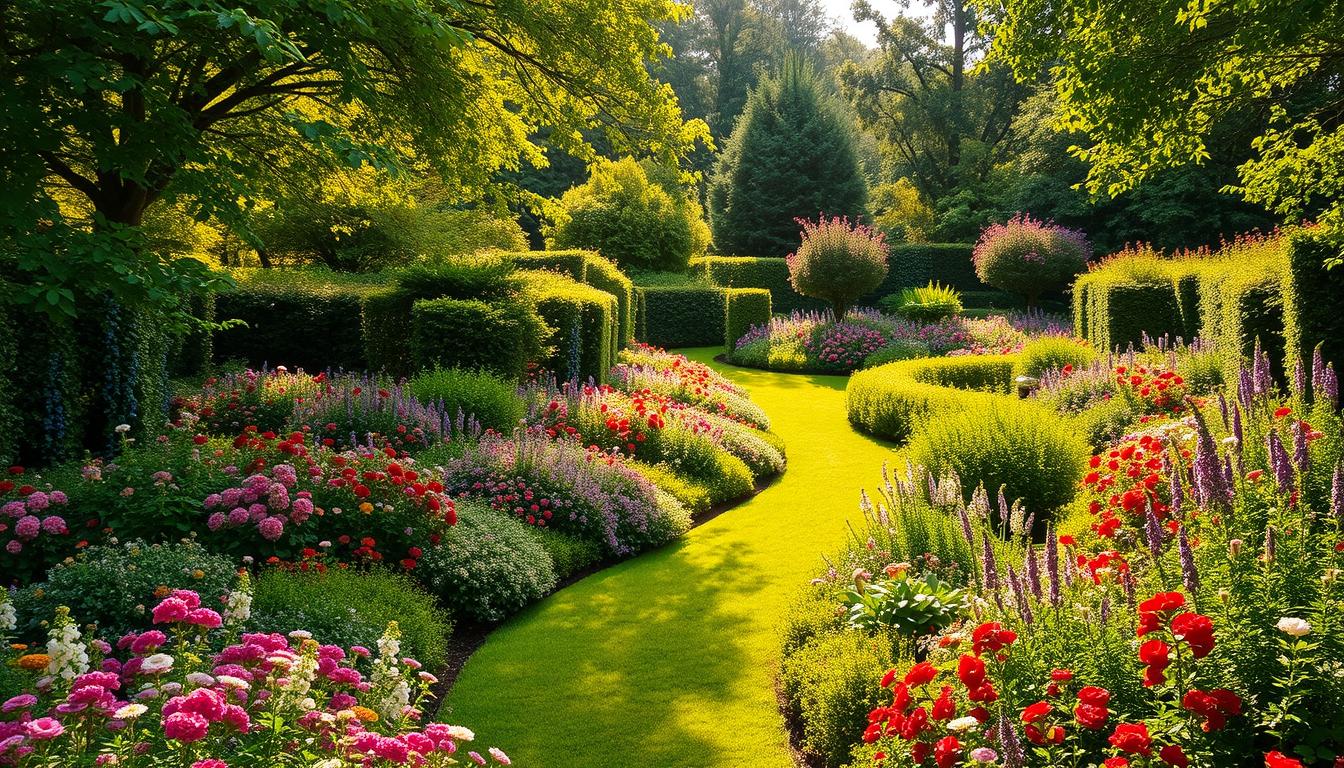Transforming your outdoor area into a functional and beautiful retreat is easier than you think. With the right design, even the smallest space can become a haven of relaxation and creativity. This guide explores 15 unique layouts to suit every need, from raised beds to wildlife-friendly setups.
Whether you’re working with a compact backyard or a sprawling lawn, these garden designs cater to sustainability, aesthetics, and practicality. Real-world examples from experienced enthusiasts add credibility and inspiration to your project. Stay ahead of the curve with 2024 trends like trellis usage and innovative layouts.
Key Takeaways
- Discover 15 diverse layouts for outdoor spaces.
- Learn how to maximize small areas with creative designs.
- Explore sustainable and wildlife-friendly options.
- Get inspired by real-world examples from experienced gardeners.
- Stay updated with 2024 trends like trellis usage.
Introduction to Garden Plans and Ideas
Modern layouts blend creativity and practicality for a seamless outdoor experience. Your space can become an extension of your home, reflecting your personality and lifestyle. From simple vegetable plots to multi-functional outdoor rooms, the possibilities are endless.
Monrovia’s 2024 guides showcase over 10 design palettes and habitat-focused layouts. These expert-curated options emphasize sustainability and beauty. Matching your layout to your climate, space, and lifestyle ensures a perfect fit.
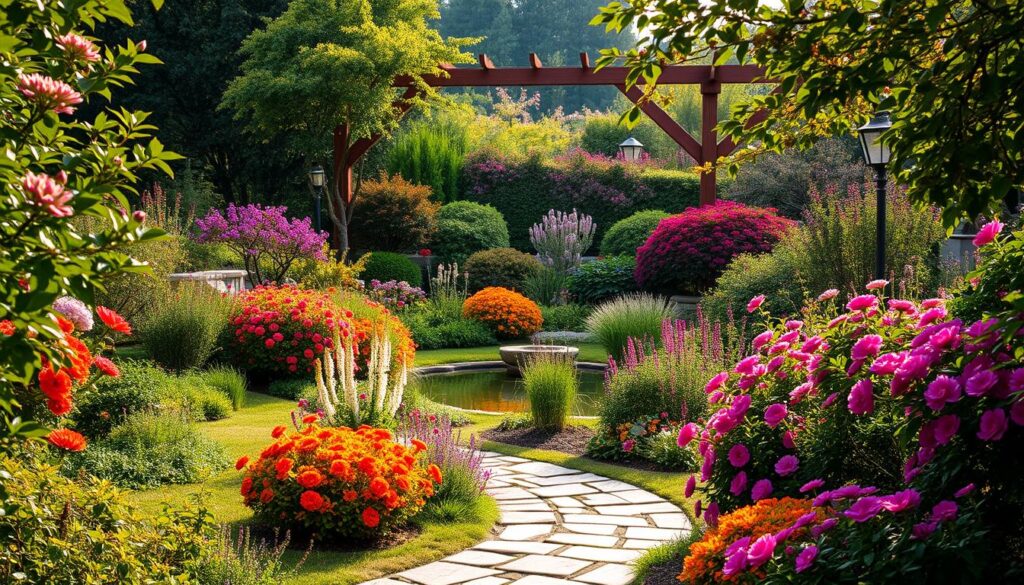
The concept of “layers” is key to a well-rounded layout. Edible layers include herbs and vegetables. Decorative layers feature flowers and ornamental plants. Structural layers, like trellises and pathways, add functionality and visual appeal.
| Layer Type | Examples | Purpose |
|---|---|---|
| Edible | Herbs, Vegetables | Provide fresh produce |
| Decorative | Flowers, Ornamental Plants | Enhance visual appeal |
| Structural | Trellises, Pathways | Add functionality and design |
Whether you’re a beginner or an experienced enthusiast, these ideas inspire creativity. Start with a clear vision and let your space evolve into a personalized retreat.
Why Garden Plans Matter
Strategic planning ensures your plants thrive while maximizing your space efficiently. A well-designed layout can make all the difference, whether you’re growing vegetables or creating a relaxing retreat.
For example, Square-Foot Gardening (SFG) yields up to four times more crops than traditional rows. This method focuses on strategic plant placement, allowing you to grow 16 carrots per square foot. It’s a game-changer for small areas.
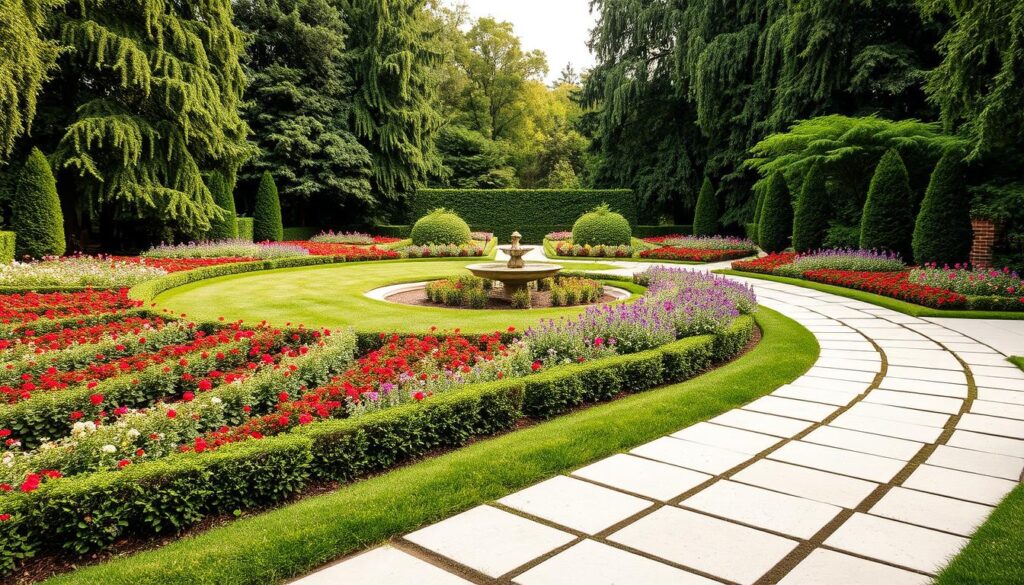
Common mistakes, like overcrowding tomatoes or shading sun-loving herbs, can be avoided with thoughtful planning. Seasonal rotation ensures year-round interest, while companion planting reduces maintenance and boosts plant health.
“A smart layout not only enhances productivity but also adds value to your property.”
Professional-grade designs, like those from Monrovia’s 2025 trend reports, can elevate your space to the next level. Here’s a quick breakdown of the benefits:
| Benefit | Example | Outcome |
|---|---|---|
| Maximize Harvests | SFG: 16 carrots/sq ft | Higher yields in less space |
| Reduce Maintenance | Companion Planting | Healthier plants, fewer pests |
| Increase Property Value | Professional Designs | Enhanced curb appeal |
By investing time in planning, you create a functional and beautiful outdoor area that works for you. It’s the best way to ensure your efforts pay off.
Choosing the Right Garden Layout
Finding the perfect layout for your outdoor space can transform it into a productive and inviting area. Whether you’re growing a vegetable garden or creating a relaxing retreat, the right design ensures your plants thrive while maximizing every inch of your space.
Square-Foot Gardening
Square-Foot Gardening (SFG) is a game-changer for small spaces. This method uses 4×4-foot boxes with lattice systems, allowing you to grow over 30 plants in a compact area. Unlike traditional row gardens, SFG offers 100% harvestable space compared to just 20%.
Here’s a sample SFG plan: a 16-square grid with tomatoes, basil, marigolds, and carrots. Tall crops like corn are placed at the north end, while low-growing lettuce sits in front for optimal sun exposure. This approach ensures every plant gets the light it needs.

Backyard Garden Layouts
For larger spaces, a multi-use backyard design works wonders. Combine a central lawn with perimeter raised beds and vertical vines for a balanced look. Movable containers are a great solution to protect plants from pets or outdoor activities.
Layering is key in backyard designs. Tall plants at the back and shorter ones in front create a visually appealing and functional setup. This method also ensures sunlight reaches all your crops.
| SFG Advantage | Example | Outcome |
|---|---|---|
| Maximize Space | 16 carrots/sq ft | Higher yields in less area |
| Reduce Maintenance | Companion Planting | Healthier plants, fewer pests |
| Sun Optimization | Tall corn at north end | All plants receive adequate light |
By choosing the right garden layout, you can create a space that’s both functional and beautiful. Whether you opt for SFG or a multi-use backyard design, thoughtful planning ensures your outdoor area thrives.
Raised Bed Gardens: A Beginner’s Guide
Raised bed setups are a simple yet effective way to grow plants in any space. They provide better drainage, improved soil quality, and easier access for planting and maintenance. Whether you’re a beginner or an experienced grower, these structures can transform your outdoor area.
When choosing materials, cedar and recycled plastic are popular options. Cedar is naturally rot-resistant and durable, while recycled plastic offers longevity and eco-friendliness. Both materials ensure your garden beds last for years.

Accessibility is another key benefit. Beds that are 24 inches high with 18-inch-wide ledges make planting and harvesting easier. These ledges also double as seating, adding functionality to your setup.
The right soil mix is crucial for success. A blend of 60% topsoil, 30% compost, and 10% vermiculite ensures optimal drainage and nutrient availability. This combination supports healthy plant growth throughout the season.
Succession planting maximizes your raised bed’s potential. Start with spring peas, transition to summer peppers, and finish with fall kale. This method keeps your space productive year-round.
“A well-designed raised bed setup simplifies gardening and boosts yields.”
For winter protection, consider hoop houses with frost cloth attachment points. These structures shield your plants from harsh weather, extending the growing season.
With these tips, you can create a functional and thriving raised bed setup. It’s a beginner-friendly solution that enhances any outdoor space.
Creating a Kitchen Garden
Growing your own herbs and vegetables at home is both rewarding and convenient. A kitchen garden brings fresh flavors right to your doorstep, making it a practical addition to any space.
Start with the essential trio: tomatoes, basil, and onions. Place them within arm’s reach of your grill for easy access while cooking. This setup ensures you always have fresh ingredients on hand.
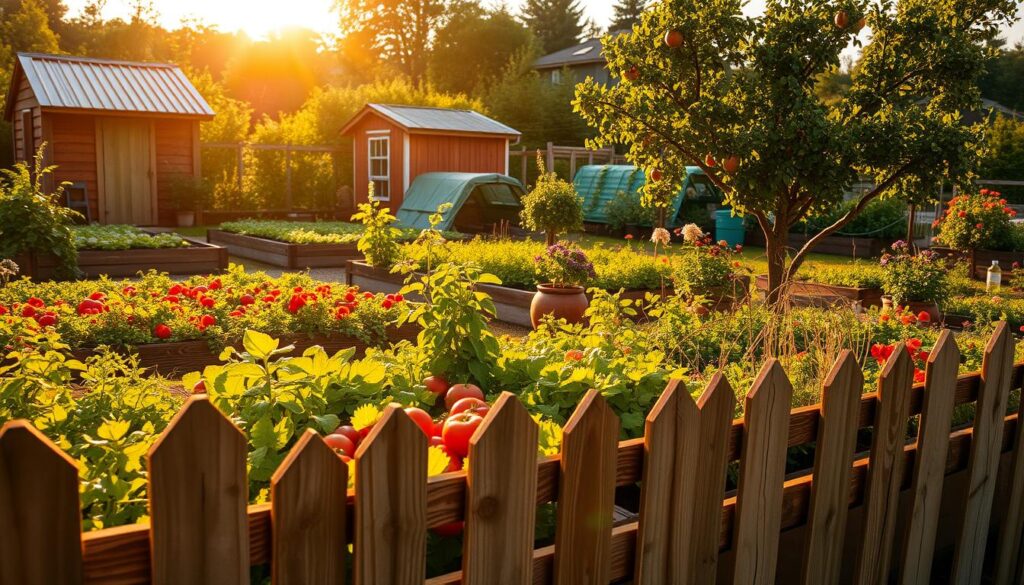
Decorative edibles like rainbow chard borders and purple bush beans add color and functionality. These plants not only look great but also provide fresh produce for your meals.
Plan for year-round harvests with succession planting. Begin with spring radishes, transition to summer dill, and finish with fall parsley. This method keeps your edible garden productive throughout the seasons.
For small spaces, consider container strategies. Windowsill herb boxes with drip irrigation are perfect for growing herbs like thyme and rosemary. They’re easy to maintain and fit seamlessly into any kitchen setup.
Pest control is essential for a thriving kitchen garden. Plant marigolds around the perimeter to deter pests naturally. Garlic spray recipes are another effective, chemical-free solution.
| Component | Example | Benefit |
|---|---|---|
| Essential Triad | Tomatoes, Basil, Onions | Fresh ingredients for cooking |
| Decorative Edibles | Rainbow Chard, Purple Bush Beans | Adds color and functionality |
| Succession Planting | Radishes → Dill → Parsley | Year-round productivity |
| Container Strategies | Windowsill Herb Boxes | Space-saving and easy to maintain |
| Pest Control | Marigolds, Garlic Spray | Natural and effective solutions |
With these tips, you can create a kitchen garden that’s both beautiful and productive. It’s a simple way to enhance your outdoor space and enjoy fresh, homegrown flavors.
Homestead Gardens for Self-Sufficiency
Achieving self-sufficiency through a homestead garden setup is both practical and rewarding. By integrating crops, livestock, and sustainable practices, you can create a balanced ecosystem that provides fresh produce and reduces reliance on external resources.
A well-designed 1/4-acre layout typically includes 70% vegetables, 20% fruit, and 10% space for poultry. This balance ensures a steady supply of food while maximizing productivity. For example, extra rows of tomatoes and cucumbers can be dedicated to canning, creating a preservation garden for year-round use.
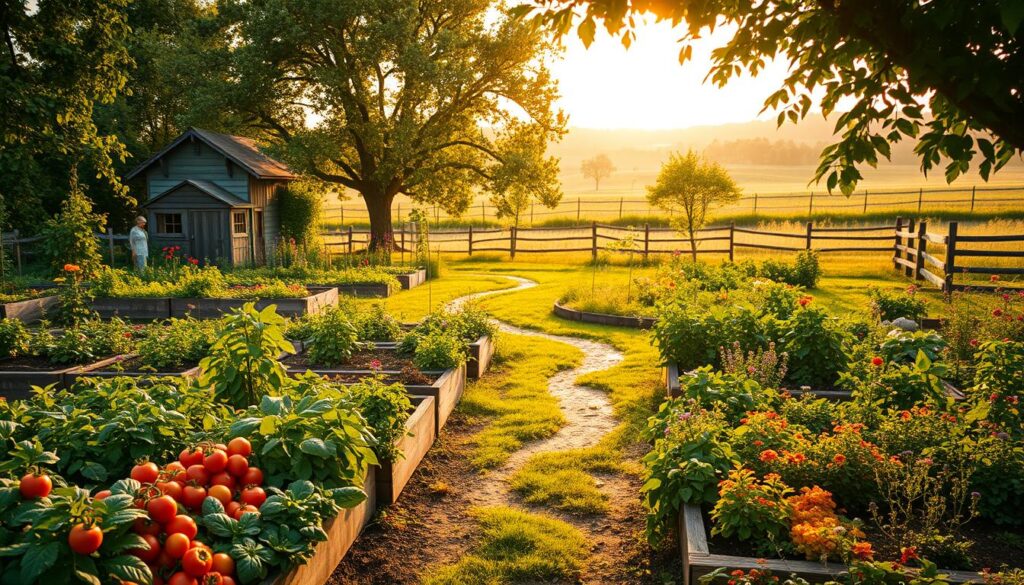
Perennial staples like asparagus beds and berry canes planted along fences add long-term value. These plants require minimal maintenance and provide consistent harvests. Pairing them with a three-bin compost system near vegetable plots enhances soil health and reduces waste.
Water independence is another key aspect of a homestead garden. A rain barrel network with drip line integration ensures efficient water use, even during dry spells. This setup not only conserves resources but also supports plant growth throughout the season.
Here’s a quick breakdown of essential components for a thriving homestead:
- Vegetable Plots: Focus on high-yield crops like tomatoes, cucumbers, and leafy greens.
- Fruit Trees and Bushes: Plant perennial staples like berries and apples for long-term harvests.
- Poultry Space: Include a chicken coop for fresh eggs and natural pest control.
- Compost System: Use a three-bin setup to recycle organic waste into nutrient-rich soil.
- Water Management: Install rain barrels and drip lines for efficient irrigation.
By thoughtfully planning your raised garden and integrating these elements, you can create a self-sufficient homestead that meets your needs and supports a sustainable lifestyle.
Maximizing Small Spaces
Even the tiniest small space can become a productive and beautiful area with the right approach. Balcony setups, for example, can yield up to 25 pounds of food in just 15 square feet. With creative solutions, you can transform limited areas into thriving environments.
Vertical stacking is a game-changer for small spaces. Start with hanging strawberries, add wall planters for herbs, and finish with tabletop microgreens. This layered approach maximizes every inch of your area while keeping it organized and visually appealing.
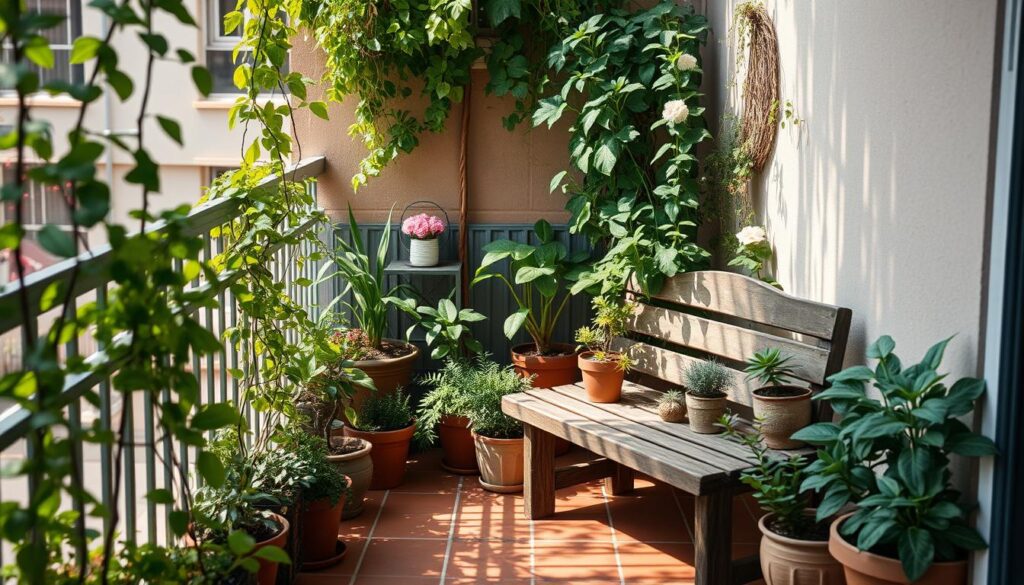
Choosing the right plants is crucial. Opt for space-saving varieties like patio tomatoes and bush-type zucchini. These compact options grow well in containers and don’t require much room to thrive.
Foldable furniture with integrated planter boxes is another smart solution. It saves space while adding functionality. You can enjoy seating and greenery without cluttering your area.
Mirrors can also work wonders. Strategically placed, they create the illusion of a larger space, doubling the visual size of your setup. This trick is perfect for making small spaces feel more open and inviting.
Community solutions like rooftop coop programs and shared lot gardens are great for urban areas. These initiatives allow you to grow more while connecting with neighbors. It’s a win-win for everyone involved.
With these tips, you can make the most of any small space. Whether it’s a balcony, patio, or corner of your yard, creativity and planning can turn it into a productive retreat.
Drought-Resistant Gardens
Creating a drought-resistant outdoor space is both eco-friendly and practical. With the right techniques, you can conserve water while maintaining a vibrant and thriving area. This approach is perfect for regions with limited rainfall or those looking to reduce their environmental impact.
Mulching is a key strategy for retaining moisture. A 3-inch gravel layer works well for arid climates, while wood chips are ideal for areas with slightly more humidity. Both options help reduce evaporation and keep the soil cool.
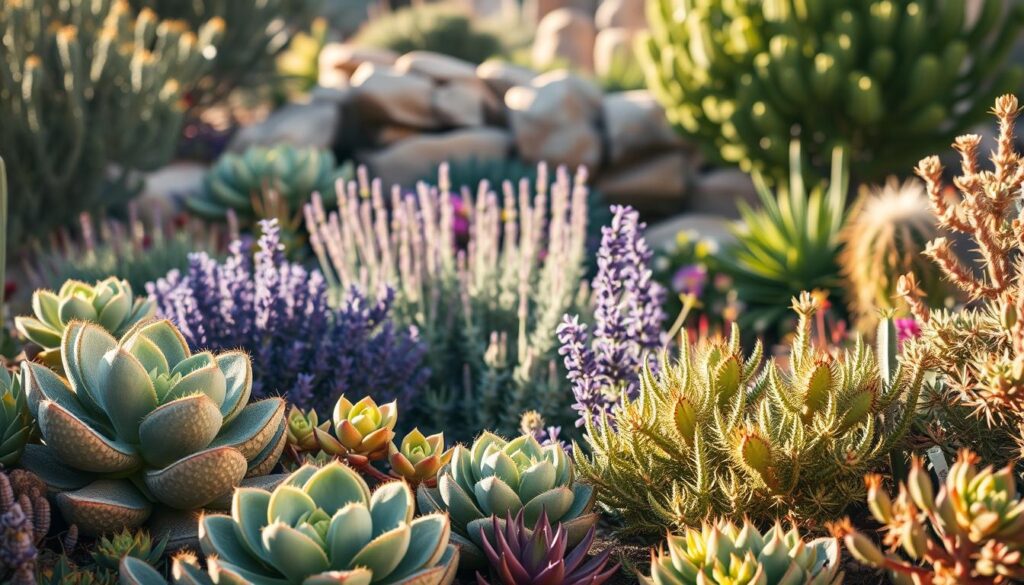
For efficient irrigation, consider buried clay ollas. These porous pots act as water reservoirs, releasing moisture slowly over two weeks. This hack ensures your plants stay hydrated without frequent watering.
Native plants like California poppies and desert marigolds are excellent choices for drought-resistant setups. They thrive in dry conditions and require minimal maintenance. Incorporating these species adds beauty and resilience to your space.
Soil preparation is crucial for success. For cactus and succulent beds, mix sand amendments to improve drainage. This ensures your plants’ roots stay healthy and free from rot.
Shade solutions like pergolas with Virginia creeper vines provide relief from the sun. These vines are drought-tolerant and add a lush, green touch to your setup. They also help reduce water loss through evaporation.
By implementing these strategies, you can create a sustainable and beautiful outdoor area. It’s a smart way to conserve resources while enjoying a thriving space.
Flower Gardens for Beauty and Pollinators
Designing a space that attracts both beauty and pollinators is a rewarding endeavor. With the right selection of flowers, you can create a vibrant area that supports wildlife while enhancing your outdoor experience.
Start with a monarch waystation plan. Plant milkweed, zinnias, and cosmos in succession to provide food and habitat for butterflies. These flowers not only add color but also play a crucial role in supporting pollinators like bees and butterflies.

For evening enjoyment, consider a night garden. Moonflowers and white lilies bloom after sunset, filling the air with their fragrance. This setup creates a magical atmosphere while attracting nocturnal pollinators.
Plan a cut flower calendar to enjoy blooms year-round. Start with spring peonies, transition to summer dahlias, and finish with fall chrysanthemums. This ensures your space is always filled with fresh flowers.
Pollinator ponds are another great addition. Use a birdbath with floating wood perches to provide water for bees and butterflies. This simple feature can make a big difference in supporting local wildlife.
Finally, establish a native wildflower meadow in five easy steps:
- Choose a sunny location.
- Prepare the soil by removing weeds.
- Select native wildflower seeds.
- Scatter the seeds evenly.
- Water regularly until established.
This approach creates a low-maintenance area that thrives with localflowersand attractspollinators.
By incorporating these ideas, you can design a space that’s both beautiful and beneficial for the environment. It’s a simple way to make a positive impact while enjoying the beauty of nature.
Companion Planting Techniques
Pairing the right plants together can create a thriving ecosystem. One classic example is the Three Sisters method, which combines squash, corn, and beans. Corn provides a natural trellis for beans, while squash covers the soil to retain moisture and deter weeds. This trio works in harmony to maximize growth and productivity.
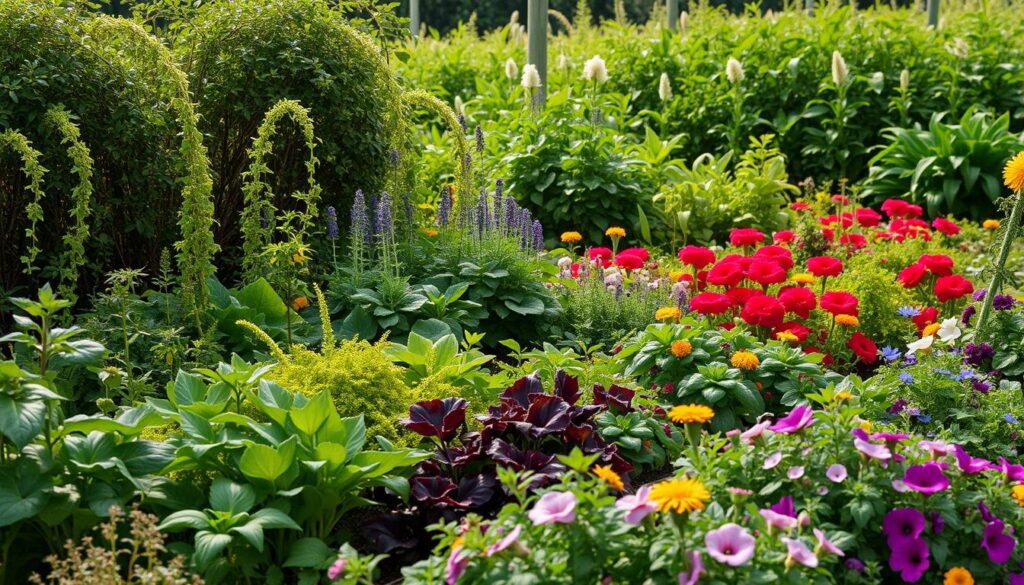
Pest control is another benefit of companion planting. Basil planted near tomatoes repels hornworms, while nasturtiums lure aphids away from broccoli. These natural solutions reduce the need for chemical pesticides, making your space healthier and more sustainable.
Nitrogen-fixing plants, like pea vines, are great companions for fruit trees. They enrich the soil, promoting healthier growth. Tall sunflowers can also provide shade for lettuce, protecting it from harsh sunlight.
“Companion planting not only boosts yields but also creates a balanced ecosystem.”
However, be cautious with allelopathic species like black walnut trees. They release chemicals that can harm nearby plants. Plan your layout carefully to avoid exclusion zones and ensure all your crops thrive.
By mastering these companion planting techniques, you can create a more productive and harmonious garden. It’s a simple yet effective way to enhance your outdoor space.
Partial-Shade Gardens
Making the most of shaded areas can lead to a lush and productive outdoor space. Even spots with limited sunlight can thrive with the right approach. By choosing shade-tolerant vegetables like kale and spinach, you can create a vibrant setup that works with your environment.
Start by mapping morning sun patterns throughout the seasons. This helps you identify the best spots for your partial-shade plants. Reflective surfaces, like white-painted walls, can boost luminosity and maximize light exposure for your crops.
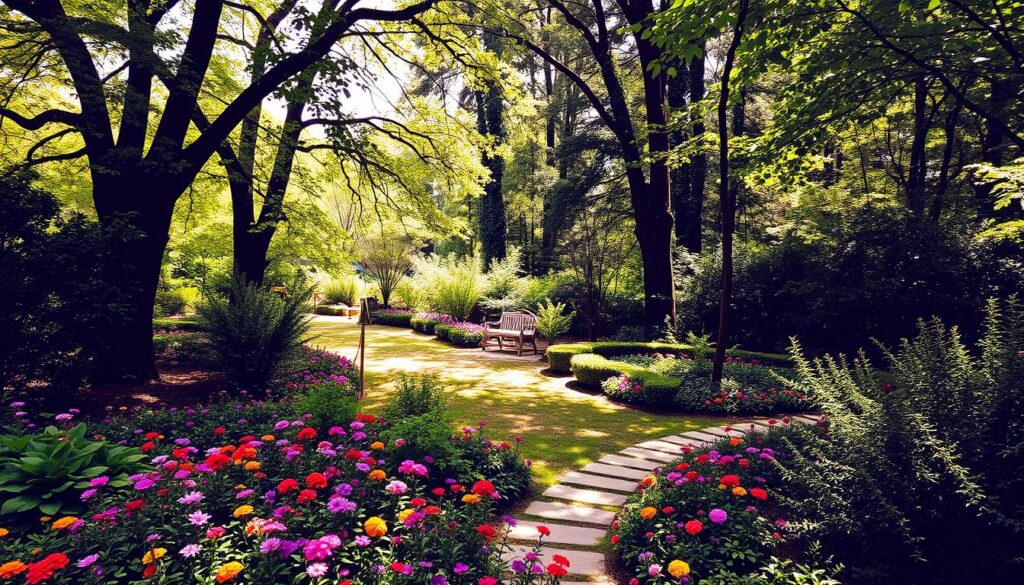
For plants that need more sun, consider rolling carts or movable containers. These allow you to chase sunlight and adjust your setup as needed. Deep shade areas are perfect for mushroom cultivation, such as shiitake logs, which thrive in low-light conditions.
Add texture and contrast with fern varieties like ostrich or autumn brilliance. These plants not only enhance the visual appeal but also thrive in shaded environments. By combining these strategies, you can transform any space into a functional and beautiful retreat.
“A well-planned partial-shade setup can turn even the darkest corners into thriving areas.”
With thoughtful planning and creative solutions, your shaded areas can become a highlight of your outdoor space. It’s a simple way to make the most of every inch, no matter the light conditions.
Using Trellises in Your Garden
Adding trellises to your outdoor space can elevate both functionality and aesthetics. These versatile structures provide support for climbing plants while maximizing vertical space. Whether you’re growing squash or creating a focal point, trellises offer endless creative possibilities.
For heavy-duty needs, cattle panel arches are an excellent choice. They’re sturdy enough to support large crops like pumpkins and squash. Quick systems, such as pea netting on bamboo teepees, are perfect for lighter climbers like peas and beans.
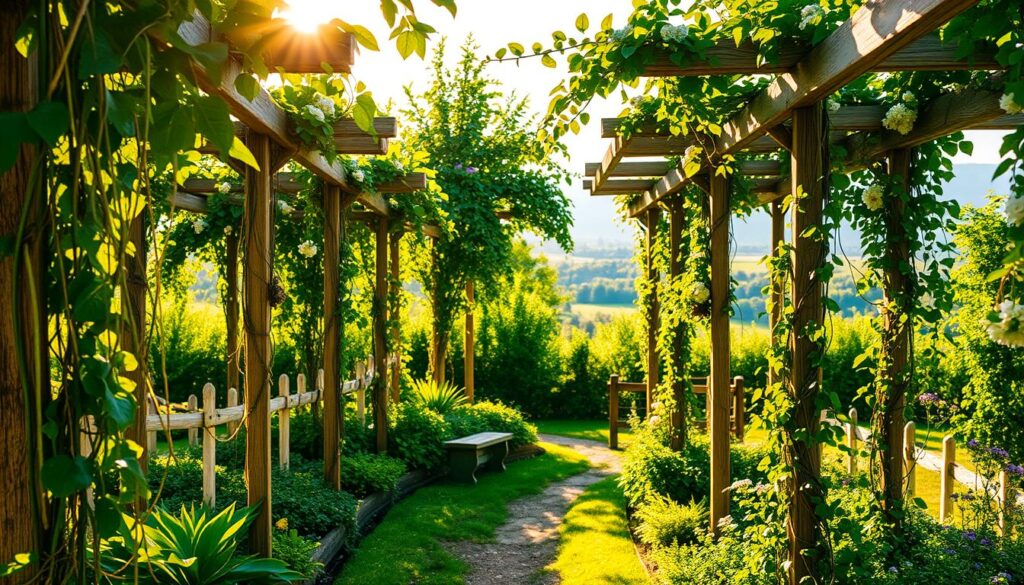
Architectural elements like obelisk focal points add a touch of elegance. Pair them with clematis or other flowering vines for a stunning visual effect. During winter, bare grapevine structures adorned with twinkle lights create a magical atmosphere.
Maintenance is simple with the right techniques. Use soft tomato ties to secure tendrils gently. This prevents damage while ensuring your plants grow healthy and strong.
“Trellises not only support growth but also add structure and beauty to any space.”
Here’s a quick guide to choosing the right trellis for your needs:
| Type | Best For | Features |
|---|---|---|
| Cattle Panel Arches | Squash, Pumpkins | Heavy-duty, durable |
| Pea Netting on Bamboo Teepees | Peas, Beans | Quick setup, lightweight |
| Obelisk Focal Points | Clematis, Flowering Vines | Architectural, elegant |
| Grapevine Structures | Winter Interest | Twinkle lights, decorative |
By incorporating trellises into your garden, you can create a space that’s both functional and beautiful. It’s a simple way to enhance your outdoor area and support healthy plant growth.
Garden Design Trends for 2024
2024 brings fresh and innovative ways to elevate your outdoor space. This year’s garden design trends focus on sustainability, technology, and creativity. From mood gardens to smart tech, these ideas will transform your landscape into a modern retreat.
Mood gardens are gaining popularity, featuring dark foliage like black mondo grass paired with burgundy heucheras. These plants create a dramatic and serene atmosphere. They’re perfect for adding depth and contrast to your outdoor area.
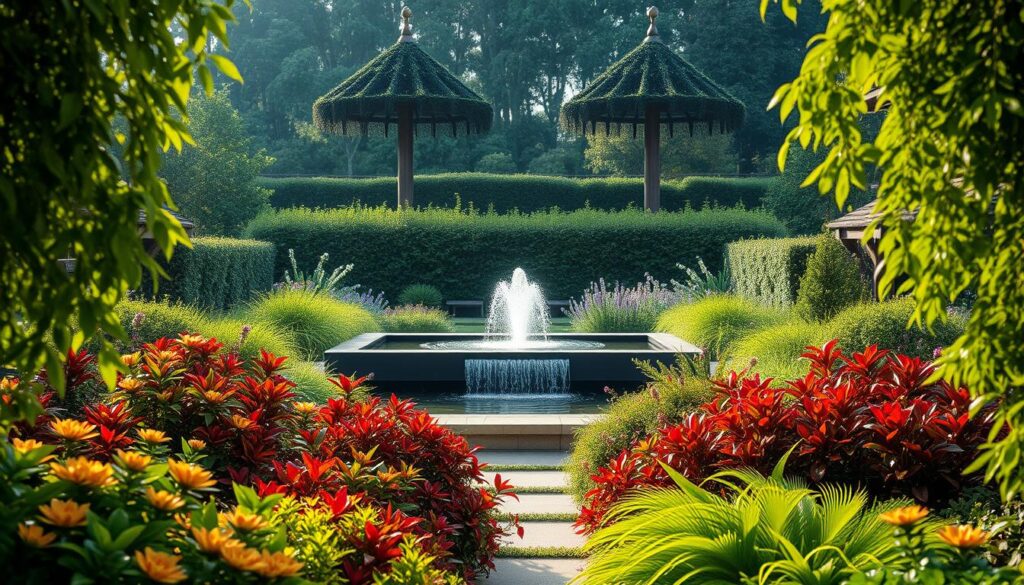
Smart technology is another key trend. App-controlled irrigation systems and soil sensors ensure your plants get the right amount of water and nutrients. These tools make garden design more efficient and eco-friendly.
Biophilic design continues to inspire. Natural stone seating encircling fire pits brings a cozy, earthy feel to your space. This approach connects you with nature while enhancing functionality.
Upcycled features are also in the spotlight. Bathtub ponds and pallet vertical gardens add unique charm and sustainability. These creative solutions turn everyday items into stunning focal points.
“2024 trends blend innovation with nature, creating spaces that are both beautiful and functional.”
Monrovia’s top 5 new plants for 2024 include Midnight Rose Coleus and Twilight Salvia. These varieties add vibrant colors and textures to your landscape. They’re perfect for staying ahead of the curve in 2024 trends.
By incorporating these ideas, you can create a modern and sustainable outdoor space. It’s a great way to embrace the latest in garden design and make your area truly unique.
Attracting Wildlife to Your Garden
Creating a welcoming environment for wildlife can transform your outdoor space into a thriving ecosystem. By incorporating simple features, you can support local species while enhancing the beauty of your surroundings.
Water features are a great starting point. A solar-powered bubbler in a bird bath provides fresh water for birds and small animals. This small addition can make a big difference in attracting diverse species to your habitat.

Shelter strategies are equally important. Brush piles offer natural hiding spots for small creatures, while bee hotels provide nesting spaces for bees. Both options are simple yet effective ways to support local wildlife.
Night-blooming plants like moonflowers and evening primrose attract moths and other nocturnal pollinators. These plants add beauty to your space while supporting nighttime ecosystems.
“A well-designed wildlife-friendly space fosters biodiversity and connects you with nature.”
Predator perches, such as owl boxes, offer natural rodent control. These structures attract owls, which help maintain a balanced ecosystem without the need for harmful chemicals.
Finally, creating chemical-free zones ensures a safe environment for all species. Manual pest removal techniques, like handpicking pests, protect your wildlife while keeping your space healthy.
| Feature | Benefit |
|---|---|
| Solar-Powered Bubbler | Provides fresh water for birds and small animals |
| Brush Piles | Offers natural shelter for small creatures |
| Bee Hotels | Supports nesting for bees |
| Night-Blooming Plants | Attracts nocturnal pollinators |
| Owl Boxes | Provides natural rodent control |
| Chemical-Free Zones | Ensures a safe environment for wildlife |
By incorporating these elements, you can create a vibrant and sustainable habitat that supports local wildlife. It’s a simple way to make a positive impact on your environment.
Seasonal Garden Planning
Planning your outdoor space around the seasons ensures year-round productivity and beauty. By following a planting schedule, you can make the most of every month and keep your area thriving.
Start your spring jumpstart with cold frame construction. This simple project allows you to grow early greens like spinach and lettuce, even in cooler weather. It’s a great way to extend your growing season.
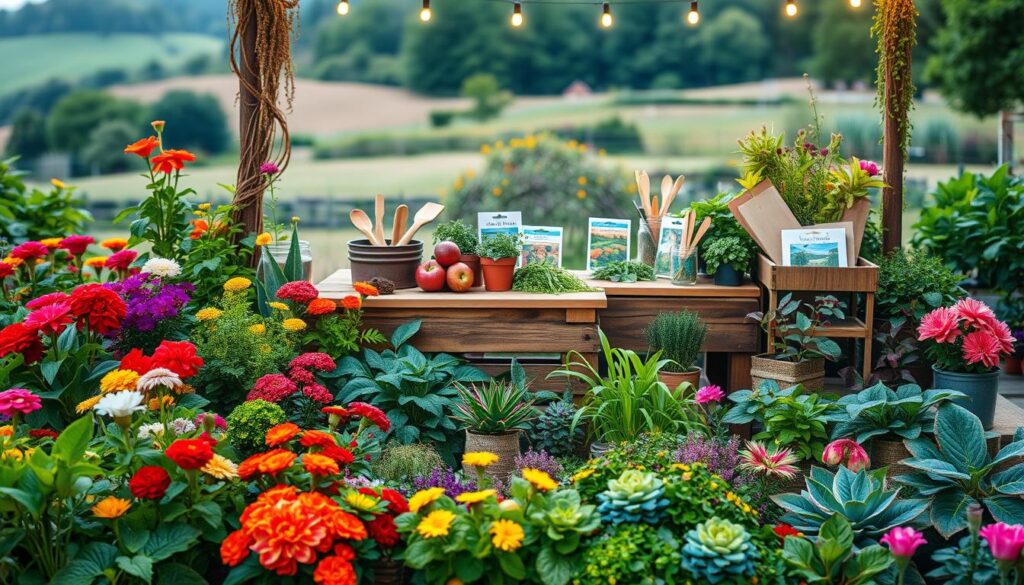
For summer, consider quick-growing hyacinth bean vine screens. These plants provide shade and add a touch of elegance to your space. They’re perfect for creating a cool retreat during hot months.
Fall is the ideal time for garlic planting. Check USDA zone dates to ensure your bulbs have enough time to establish before winter. This step sets you up for a successful harvest next year.
Winter projects like seed catalog review parties keep you engaged during the off-season. Gather friends, share ideas, and plan for the upcoming year. It’s a fun way to stay connected to your outdoor space.
“Adapting your space to the changing seasons creates a dynamic and sustainable environment.”
Finally, consider the lunar calendar for root vs leaf planting phases. Planting during the right moon phase can enhance growth and yield. It’s a natural way to optimize your efforts.
By incorporating these seasonal strategies, you can create a space that’s productive and beautiful all year long. It’s a simple yet effective approach to outdoor planning.
Conclusion: Start Your Garden Transformation Today
Your outdoor space can become a thriving haven with just a few thoughtful steps. Begin small with a herb spiral or container setup to ease into your garden transformation. These simple projects are perfect for beginners and help you build confidence.
Take advantage of community resources like seed swap events and master gardener hotlines. These tools provide valuable support and inspiration as you start today. Connecting with others can make the process more enjoyable and rewarding.
Looking ahead, 2025 trends focus on therapeutic spaces that promote relaxation and well-being. Stay ahead by incorporating calming elements into your design. Download Monrovia’s free landscape plan templates to kickstart your project.
Remember, your perfect outdoor retreat grows one plant at a time. Embrace the journey and enjoy every step of your garden transformation. For more creative inspiration, explore these boho yard decor ideas to add a unique touch to your space.

